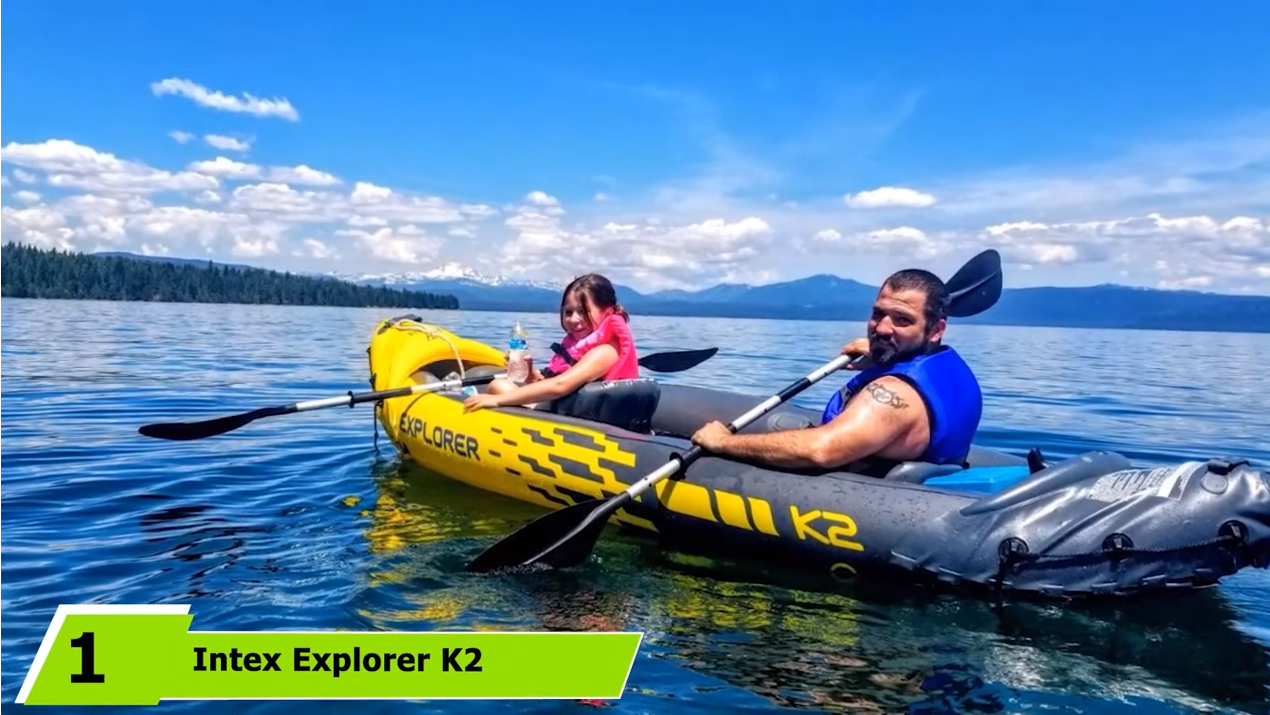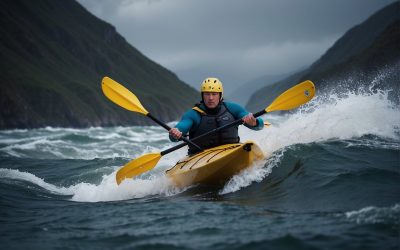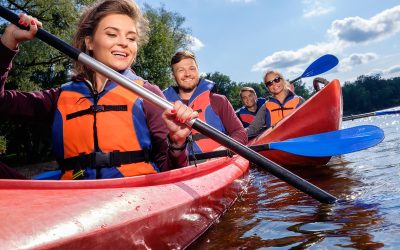Kayaking is a popular watersport that allows participants to explore and enjoy natural water features such as lakes, rivers, and oceans. Rental options cater to the diverse needs of kayakers, whether they are novices or seasoned paddlers. Understanding the process and various aspects of kayak rentals can help you make an informed decision and ensure a memorable and enjoyable experience on the water.
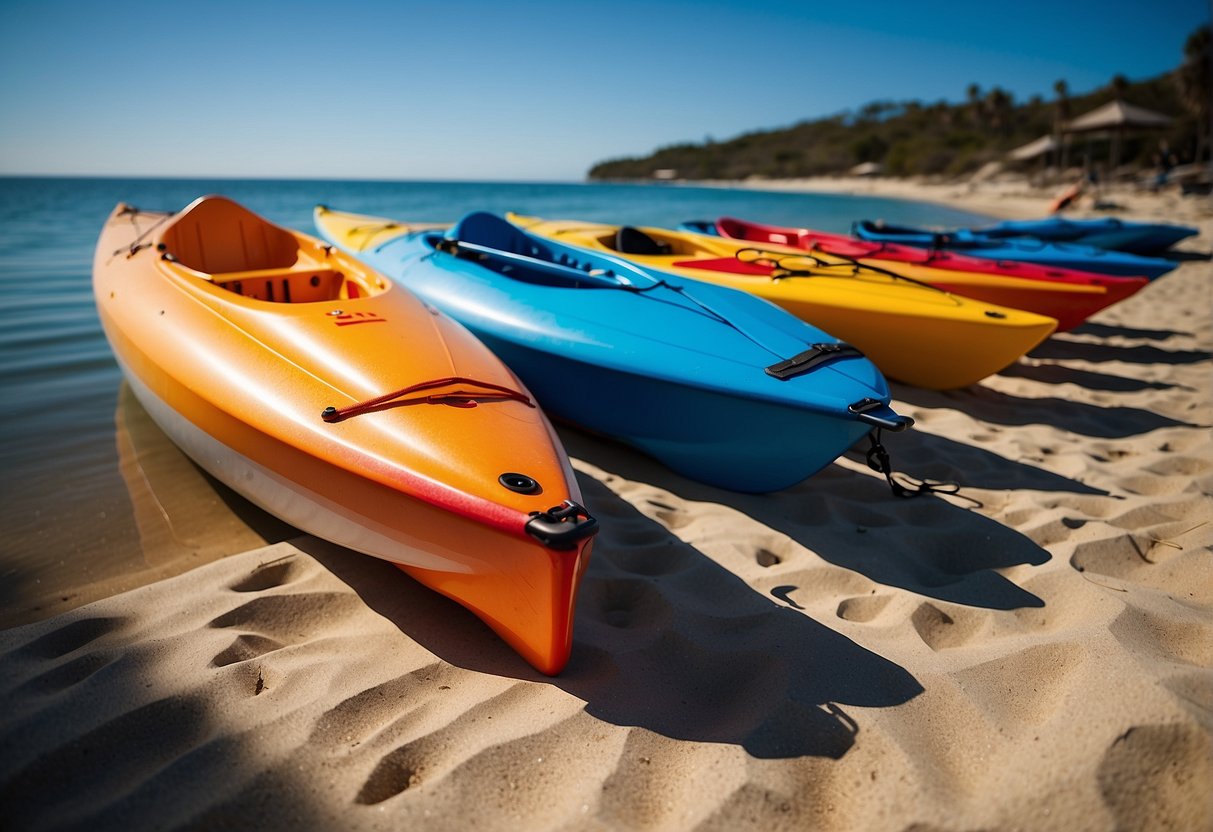
There are numerous factors to consider when renting kayaks, such as the types of kayaks available, essential equipment, and rental locations. These aspects vary depending on personal preferences, the intended activity, and the desired level of challenge. In addition, it is crucial to choose a reputable kayak rental service that prioritizes safety and provides reliable guidance for transportation and paddling techniques.
Key Takeaways
- Different kayak rentals cater to various skill levels, activities, and locations.
- Consider essential equipment, safety guidelines, and pricing when renting a kayak.
- Exploring new destinations and engaging in complementary activities can enrich the kayaking experience.
Understanding Kayak Rentals
Kayak rentals provide an excellent opportunity for experienced and novice paddlers to enjoy the water without needing to purchase their own equipment. When considering rental options, it’s essential to understand the various types of kayaks available and what to expect during the rental process.
Sit-on-top kayaks and sit-in kayaks are the two main categories available for rent. Sit-on-top kayaks are user-friendly and popular for recreational paddling, as they are easy to get on and off. On the other hand, sit-in kayaks are more suitable for experienced paddlers or those looking for a more challenging experience for better maneuverability.
Before committing to a kayak rental service, ensure you know the available options and their rates. Rental fees typically range between $10 and $20 per hour or $50 and $95 per day and vary depending on the type and size of the rented kayak.
Remember that tandems, or double kayaks, often have higher rental fees than single kayaks due to their size and additional capacity for multiple paddlers. Paddleboards are another option for those interested in water sports, but they require different skills and gear than kayaking.
Here is a quick comparison of the various kayak rental options:
| Equipment | Ideal For | Rental Fee Range |
|---|---|---|
| Single Kayak | Solo paddlers | $10-$20 per hour, $50-$95 per day |
| Tandem Kayak | Pairs of paddlers | Higher compared to single kayaks |
| Paddle Board | Stand-up paddling | Similar to kayak rental rates |
Once you have chosen the kayak and rental service type, inquire about any additional equipment provided, such as life jackets, paddles, and any safety gear. Also, consider the rental location’s proximity to the water and whether they offer transportation assistance or launching services.
In summary, understanding kayak rentals will help you decide when choosing the right type of kayak and rental service for your needs. By paying attention to factors like rental fees, equipment availability, and location, you can ensure that your kayaking experience will be enjoyable and suited to your abilities.
Types of Kayaks Available
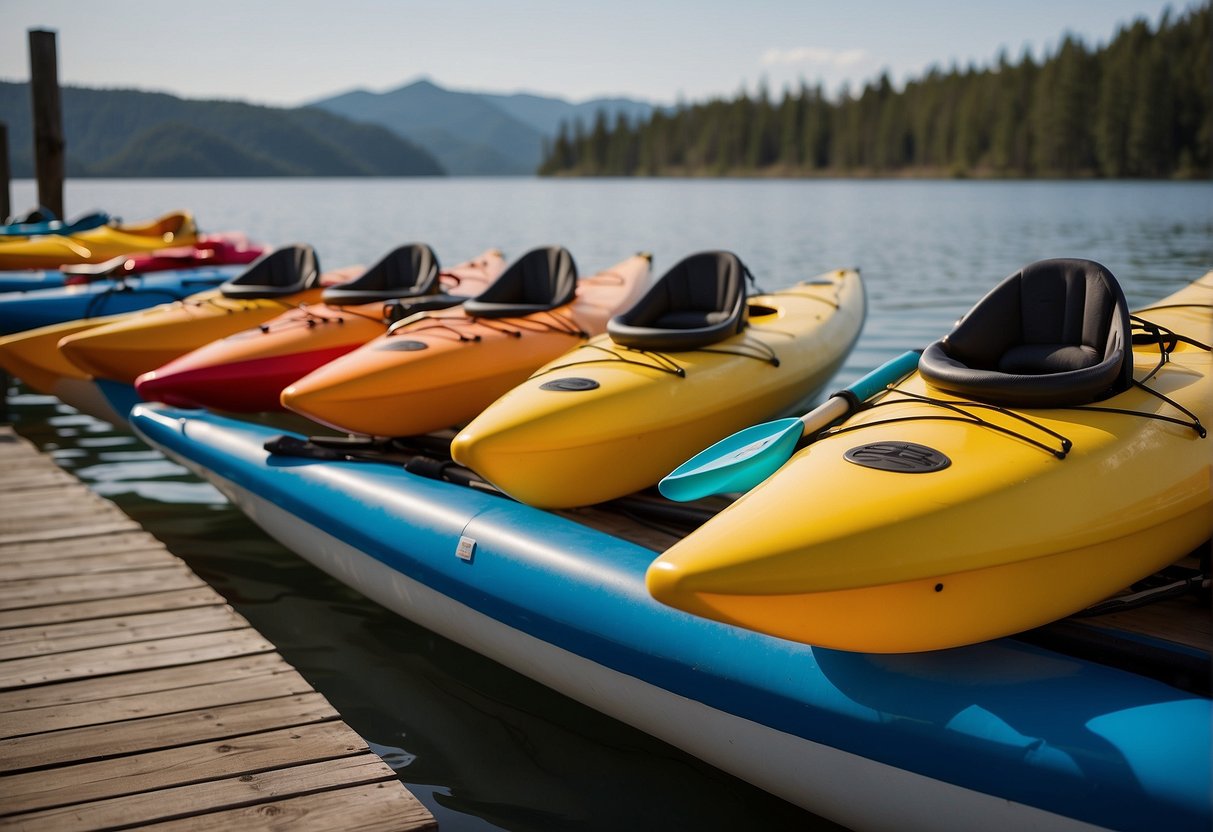
Single Kayaks
Single kayaks are designed for one person and come in various styles to suit the paddler’s needs. The two main types include sit-on-top kayaks and sit-in kayaks. Sit-on-top kayaks are user-friendly and popular for recreational paddling because they are easy to get on and off. In contrast, sit-in kayaks provide a more enclosed seating area suitable for various water conditions, including whitewater kayaking and touring. When renting a single kayak, consider factors such as skill level, the type of water, and personal preferences. Most rental companies include equipment like a personal flotation device (PFD) in the price.
Tandem Kayaks
Tandem or double kayaks are designed for two people to paddle together. They offer a fun and social experience for couples, friends, and family members. Tandem kayaks are available in sit-on-top and sit-in styles, with similar benefits to their single counterparts. When renting a tandem kayak, it’s essential to consider both paddlers’ skill level and experience, as well as the type of water you’ll be navigating. Rental prices for tandem kayaks are typically higher than single kayaks, but it’s often more cost-effective than renting two separate kayaks.
Fishing Kayaks
Fishing kayaks are specialized kayaks designed with features to enhance your angling experience. They often come with additional storage for fishing gear, rod holders, and adjustable seating for comfort during long fishing sessions. Some fishing kayaks have pedal systems or motor mounts, allowing hands-free fishing movement. Fishing kayak rentals are a popular option for those who want to combine their love for kayaking with their passion for fishing without the need to purchase or transport their kayak.
Inflatable Kayaks
Inflatable kayaks offer a convenient and portable alternative to traditional hard-shell kayaks. They are typically made from durable materials, making them resistant to punctures and suitable for various water conditions. Inflatable kayaks can be easily deflated and stored in a compact space, so you won’t need car rentals with a roof rack to transport them to your desired location. Many rental companies provide inflatable kayaks for both single and tandem use. These kayaks are well-suited for beginners and casual paddlers who prioritize ease of use and portability in their kayaking experience.
Kayaking Equipment Essentials
Paddles and PFDs
When renting a kayak, it is essential to ensure that you have the right equipment, starting with suitable paddles and a Personal Flotation Device (PFD), commonly known as a life vest. Paddles come in various sizes and materials, so choosing one that matches your skill level and the type of kayaking you plan to do is vital. Rental companies often provide introductory paddles, but investing in ergonomic or performance-enhancing options may prove beneficial.
PFDs are a crucial safety measure for all kayakers, regardless of experience. Many kayak rental companies provide life vests with their rentals. Ensuring that your life vest fits appropriately and meets safety standards is essential. If you prefer having your own PFD, various types and designs are available to suit individual needs.
Safety Gear
Beyond the introductory paddles and life vests, additional safety items should be considered when renting a kayak. Here are some essentials to remember:
- First-aid kit: In case of minor injuries, having a first-aid kit on hand is beneficial.
- Emergency shelter: Depending on your trip’s duration and location, having an emergency shelter or a tent with you might be wise.
- Communication tools: A cellphone, a protective case, a waterproof container, and a signaling device for emergencies are essential.
- Navigation tools: A compass, map, or GPS device can be valuable if you get lost or need to find your way back to shore.
Additional Accessories
Lastly, some optional accessories may enhance your kayaking experience:
- Sun protection: Sunscreen, lip balm with SPF, and sunglasses will protect you from the sun’s harmful rays during your kayaking trip.
- Insect repellent: Depending on the location and season, insect repellent might be necessary to keep bugs at bay.
- Dry bags: To keep your belongings safe and dry, consider using dry bags for storing your items in the kayak.
In summary, when renting a kayak and preparing for your adventure, it’s essential to have the appropriate equipment, paying close attention to paddles, PFDs, essential safety gear, and additional accessories to ensure a safe and enjoyable experience.
Where to Rent Kayaks
Beachfront Rentals
Beachfront rentals are popular for those looking to enjoy kayaking on the ocean. Many coastal cities, such as Destin, offer a variety of rental providers with convenient access to the water. These providers typically provide hourly and daily rental options, including single and tandem kayaks, lifts, e-vests, and paddles.
Lakeside Providers
Lakeside providers are ideal for exploring calm waters and picturesque surroundings. You can often find rental options near famous lakes like Nice, Paris, and Canada. Many providers offer a range of equipment, from kayaks to stand-up paddleboards. Renting from lakeside providers usually includes basic instruction and safety gear, ensuring a comfortable and enjoyable experience.
River Outfitters
River Outfitters specializes in providing rentals and guided trips for those seeking an adventurous kayaking experience. Popular in areas marked by stunning cliffs and challenging rapids, river outfitters serve as ideal options for thrill-seekers. These providers often feature different types of kayaks, such as sit-on-top and inflatable ones, that cater to varying skill levels and preferences. A reliable river outfitter is PaddleBreak Adventures, offering rentals for kayaks, canoes, and paddleboards.
National Parks
Finally, national parks often present fantastic kayaking opportunities to explore breathtaking lakes and rivers. Many parks have visitor centers that provide kayak rentals and necessary equipment. Additionally, some parks may offer guided tours to help you discover the unique natural landscapes and wildlife found within their boundaries. When planning a visit to a national park, be sure to research the available rental options and services to enhance your kayaking adventure.
Choosing the Right Kayak Rental Service
Reputation and Reviews
When selecting a kayak rental service, it is essential to consider the company’s reputation and previous customer feedback. Online reviews can provide valuable insight into the quality of service and the overall experience past clients had with the company. A rental service with consistently high ratings is more likely to offer a satisfactory experience. In addition to reviews, confirm the company’s safety record to ensure they prioritize your wellbeing on the water.
Service Offerings
Different kayak rental companies provide varying services. When assessing potential options, consider the types of kayaks they offer, ensuring that they cater to your experience level, intended use, and water conditions. A service that supplies stable, maneuverable recreational kayaks would be ideal for beginners. Those planning to explore calm lakes or slow-moving rivers may find recreational kayaks or touring kayaks more suitable. Moreover, inquire about equipment inclusions, potential group discounts, and any additional perks they may provide their customers.
| Service Feature | Importance |
|---|---|
| Kayak Types | Ensure the company offers kayaks appropriate for your experience level and the intended water conditions. |
| Equipment | Find out what equipment the rental includes (e.g., paddles, life jackets, etc.) |
| Group Discounts | Ask if the company offers discounts for larger groups or multiple rentals |
Rental Policies
Before committing to a kayak rental service, please familiarize yourself with their policies to avoid confusion or unexpected fees. For instance, examine their cancellation policy to know how flexible they are with changes or cancellations. Additionally, inquire about their payment options and whether they require a credit card for reservations or security deposits. Understanding these policies upfront can help you make an informed decision and avoid surprises.
Kayaking Safety Guidelines
Kayaking is an enjoyable water activity for all ages, but following safety guidelines is essential to ensure a secure and pleasant experience. By adhering to these comprehensive safety measures, you can prevent accidents and enjoy an outstanding kayaking trip.
Wearing a Personal Flotation Device (PFD) or life vest is a vital component of kayaking safety, which significantly increases the chances of survival in an unexpected capsizing. PFDs should be worn by kayakers of all skill levels, including children and adults, throughout the entire trip.
Before kayak excursions, it is crucial to be informed of the current weather and water conditions. Keep an eye on the forecast and be prepared for sudden changes in temperature, winds, or rainfall. Knowing the environment will help you decide whether to proceed with the journey or reschedule for improved conditions.
For families with children participating in kayaking, it is essential to ensure that their life vests are appropriately sized and secure. Additionally, teach children basic paddling techniques and safety rules, such as staying close to the group and following instructions from the guide.
When renting a kayak, consider choosing an accessible storage area to carry safety gear and equipment, such as helmets, GPS devices, or marine radios. These essential items can drastically improve your safety and help you stay connected to the group while on the water.
To sum up, prioritize safety when planning a kayaking trip by wearing PFDs, closely monitoring weather conditions, and ensuring the wellbeing of children. Taking these precautions and using the appropriate safety gear will provide peace of mind for an enjoyable kayaking experience.
How to Transport Kayaks
Car-Rooftop Carriers
Car rooftop carriers are a popular way to transport kayaks. They provide a secure way to fasten your kayak to the top of your vehicle using roof racks and specialized accessories. Safety and stability are paramount when transporting heavy gear like kayaks, so invest in a high-quality roof rack system. Some kayakers also recommend using a cockpit cover to protect the inside of the kayak during transportation.
To successfully transport your kayak using a car-rooftop carrier, follow these steps:
- Install your roof rack system according to the manufacturer’s instructions.
- Position your kayak on its side with the cockpit facing out.
- Secure the kayak to the roof rack using straps and, if necessary, additional padding to prevent damage.
- Ensure the kayak is tightly fastened and secure before starting your drive.
Trailer Transport
For those who need to transport multiple kayaks or have a vehicle equipped with a tow bar, kayak trailers are an excellent option. These trailers come in various sizes and configurations, accommodating different types and numbers of kayaks.
To set up your kayak trailer, follow these steps:
- Attach the trailer to your vehicle using the appropriate tow hitch.
- Load the kayaks onto the trailer, balancing the weight evenly.
- Secure the kayaks tightly using straps and padding if needed.
- Double-check the trailer’s setup and the vehicle’s connection before hitting the road.
On-Site Rentals
Another way to enjoy kayaking without the hassle of transportation is to rent kayaks on-site. Many locations, especially famous lakes and rivers, offer on-site kayak rentals for those who don’t own a kayak or prefer not to transport one. This option provides convenience, as you can pick up a kayak at the destination and return it when you’re done.
Keep in mind:
- On-site rental prices vary based on location, kayak type, and duration.
- Reserving your kayak in advance is recommended, especially during peak seasons.
- Don’t forget to inquire about additional equipment like paddles, life jackets, and safety gear.
Paddling Techniques and Tips
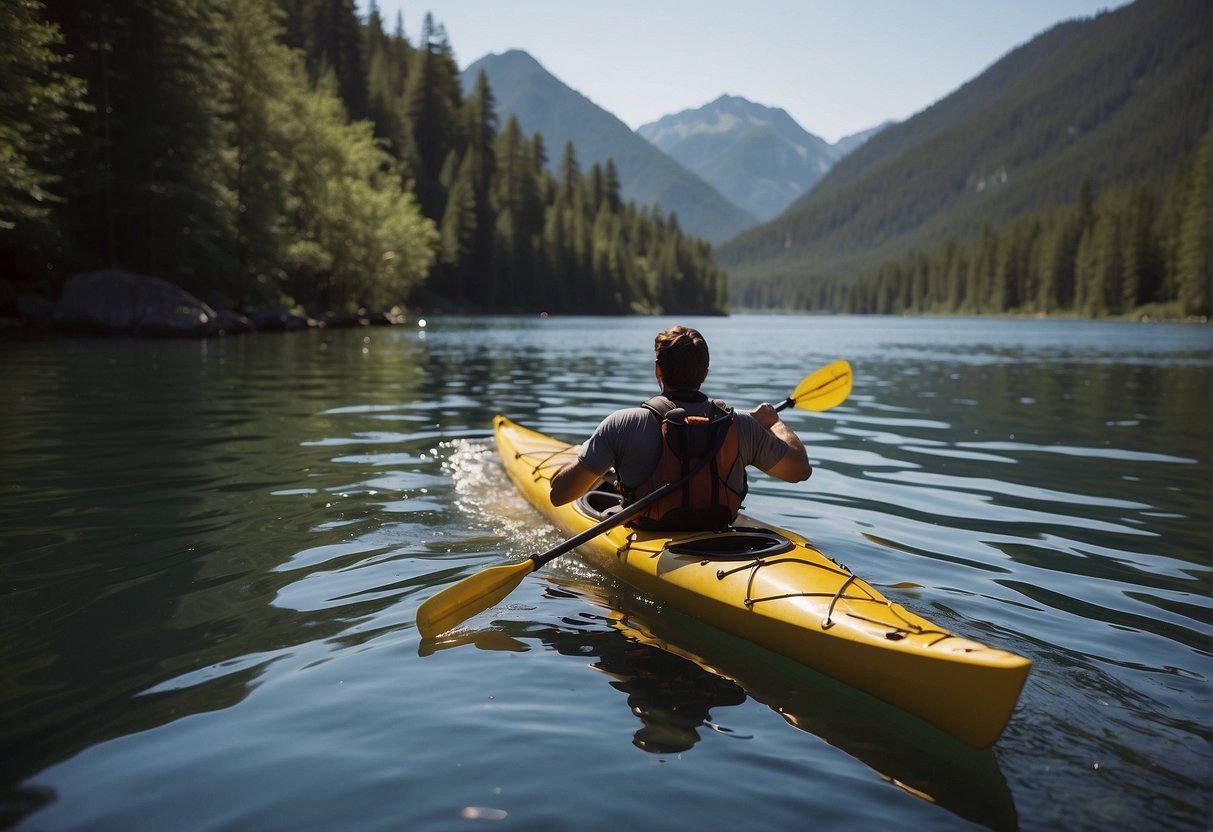
Kayaking is an exciting way to explore waterways, and knowing proper paddling techniques is essential for a smooth kayaking experience. Whether you are a beginner or an experienced paddler, these tips will improve your skills and help you during your next kayak rental.
First, ensure you have the necessary equipment, such as a personal floatation device (PFD), a comfortable, high-quality kayak paddle, and appropriate clothing for a wet environment1. Once you’re geared up, the key to efficient paddling is mastering your technique in safe, calm waters before venturing into rougher conditions.
- Body Position: Sit upright and maintain good posture in your kayak. Engage your core muscles to help maintain balance. Your feet should be on the footrests, with knees bent slightly outward to grip against the kayak’s sides.
- The Forward Stroke is the most common paddle stroke for kayak propulsion. Dip the blade into the water near your toes and pull it through the water parallel to the kayak. Rotate your torso and use your core muscles to generate power while maintaining a relaxed grip on the paddle2.
- The Sweep Stroke: To turn your kayak, use a sweeping motion, moving the paddle in a wide arc away from the boat. Please start with the blade near your toes and push it away from the ship clockwise (counterclockwise on the opposite side).
- The Reverse Stroke: To stop or move backward, paddle in the opposite direction of the forward stroke. Begin with the paddle blade near your hips and push it through the water toward your toes, keeping the paddle parallel to the boat.
Kayaking in open water or rivers may require additional techniques, such as the Eskimo roll for recovering from a capsized position3 or surfing and playboating techniques for handling waves and rapids. As you progress, consider joining a local kayaking community to learn from others and share your experiences.
Remember, practice makes perfect, so practice your paddling techniques and enjoy your time on the water!
Footnotes
Seasonal Considerations for Kayaking
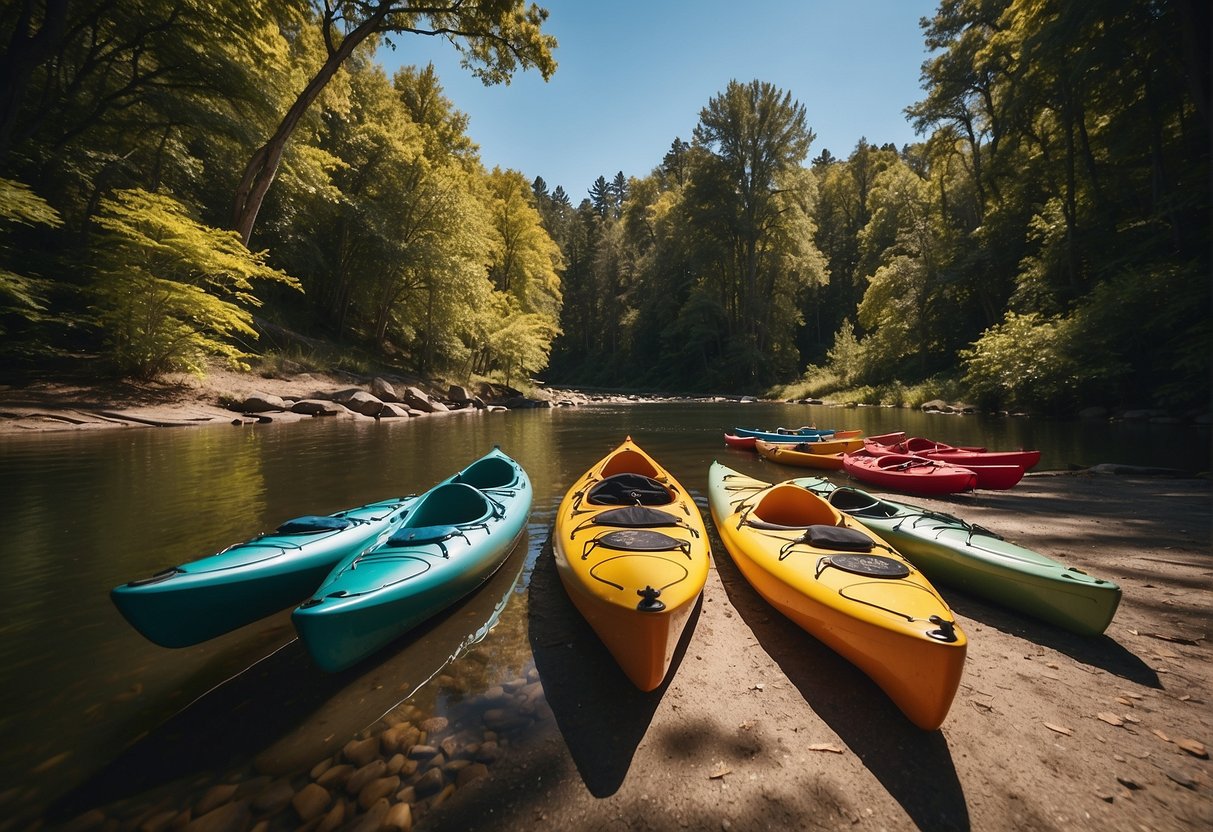
When planning a kayaking adventure, it’s essential to consider the seasonal aspects that will impact the overall experience. The conditions can vary drastically depending on the time of year, and being prepared for the various challenges will ensure a safe and enjoyable outing.
The weather is usually more predictable during the warmer months, and longer daylight hours provide ample time to paddle and explore. This season, wearing lightweight clothing, sunscreen, and protective eyewear with UV filters is crucial. Don’t forget to stay hydrated, as the sun and physical activity can take a toll on the body. Popular travel sites often provide information on prime kayaking locations and the best times to visit during summer.
| Season | Weather Conditions | Clothing & Gear |
|------------|----------------------------|-------------------------------|
| Spring | Cool & Unpredictable | Layers, Dry Suits, Gloves |
| Summer | Warm & Sunny | Light Clothing, Sunscreen |
| Autumn | Cool & Unpredictable | Layers, Dry Suits, Gloves |
| Winter | Cold & Harsh | Wet Suits/Foul Weather Gear |
Cooler temperatures characterize spring and autumn, making the weather more unpredictable. It’s essential to dress in layers and consider wearing dry suits or other waterproof gear, as well as gloves to protect against the colder water and air temperatures. Monitoring the weather forecast in advance is vital during these seasons, as sudden storms or hazardous conditions may require plan adjustments.
While winter kayaking may not appeal to everyone, it can provide a unique and serene paddling experience. Staying warm and protected from the elements is critical during this season. Wearing wet suits or foul weather gear, investing in neoprene gloves and booties, and using a reliable kayak skirt will help keep paddlers comfortable and dry. Remember, winter days are much shorter, so planning trips with adequate daylight is crucial. Also, always check local regulations, as certain bodies of water may have restricted access during this time of year.
In summary, being aware of seasonal factors and adequately preparing for the weather, sunlight, and other conditions is a significant aspect of planning a successful kayaking trip. With the right gear and knowledge, paddlers can thoroughly enjoy their time on the water, regardless of the season.
Planning Group Kayak Rentals
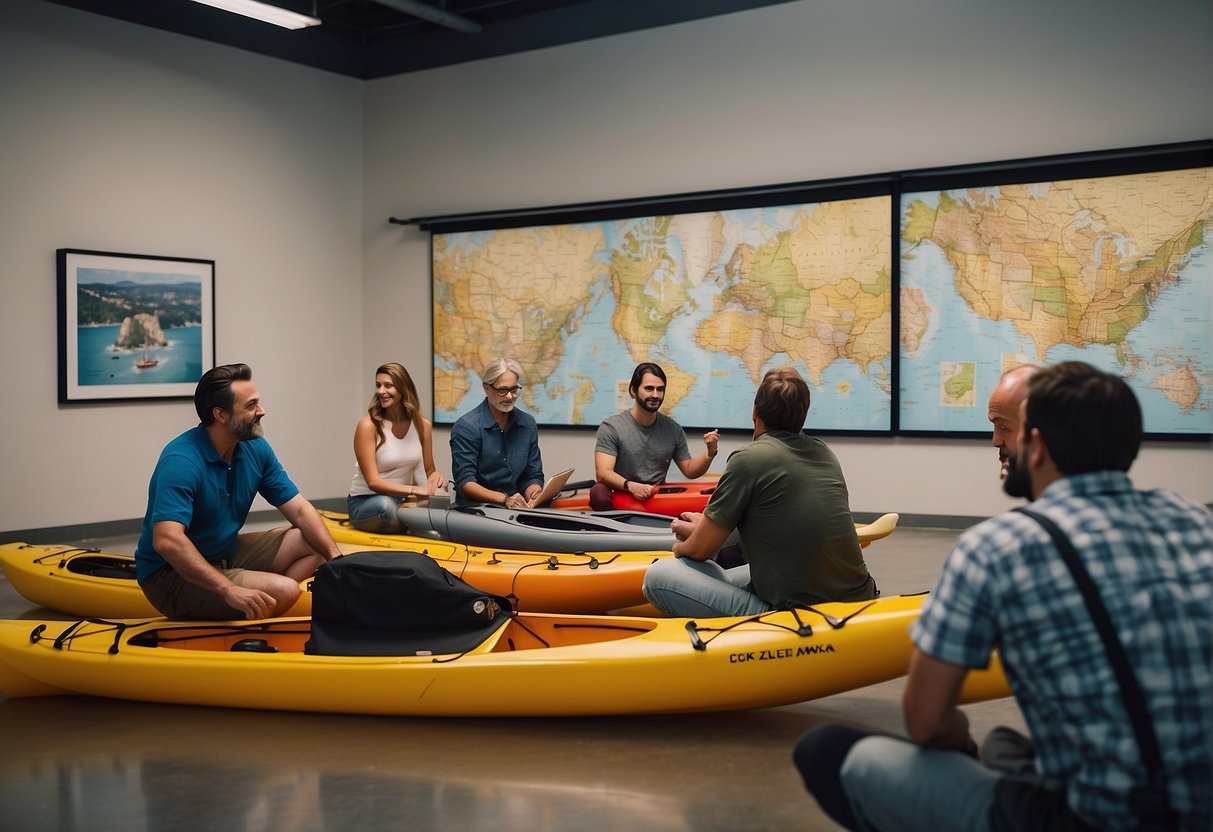
When planning a group kayak rental, one of the first steps is to research various rental options available in your desired location. Companies such as Kayak Rentals La Jolla and Kayak Rentals in Coronado offer multiple options, including single and tandem kayaks that accommodate different group sizes and skill levels.
When considering rental options, it’s essential to keep the group’s needs in mind. For instance, some members prefer single kayaks, while others feel more comfortable in a tandem kayak with a partner. Ensuring everyone’s safety is essential, so select a rental company with well-maintained equipment and proper instructions on using them.
To keep everyone engaged and entertained during the trip, it’s beneficial to consider the interests of the group members. For example, you can plan the route to pass by scenic spots or ecological reserves, such as La Jolla’s famous 7 Caves. Planning also involves selecting a rental duration that fits your group’s schedule and stamina. Some companies offer hourly, half-day, or full-day rentals to suit various needs.
When involving children in the group kayak rental, you should consider their age, physical ability, and comfort level with water activities. Many rental companies have age and weight restrictions for their kayaks, so checking their specific guidelines is vital. Offering a guided kayak tour can be an ideal solution for groups with children, as experienced guides can provide additional support, safety measures, and even educational information during the trip.
Lastly, making reservations well in advance is essential, especially for larger groups or during peak seasons. Booking early ensures the availability of kayaks and equipment and allows the group to benefit from potential discounts or promotions that some rental companies might offer.
With careful planning, a group kayak rental can become a memorable and enjoyable experience for everyone involved. By considering the group’s needs, interests, and safety, you can create a kayak adventure that leaves a lasting impression on all participants.
Kayak Rental Pricing and Fees
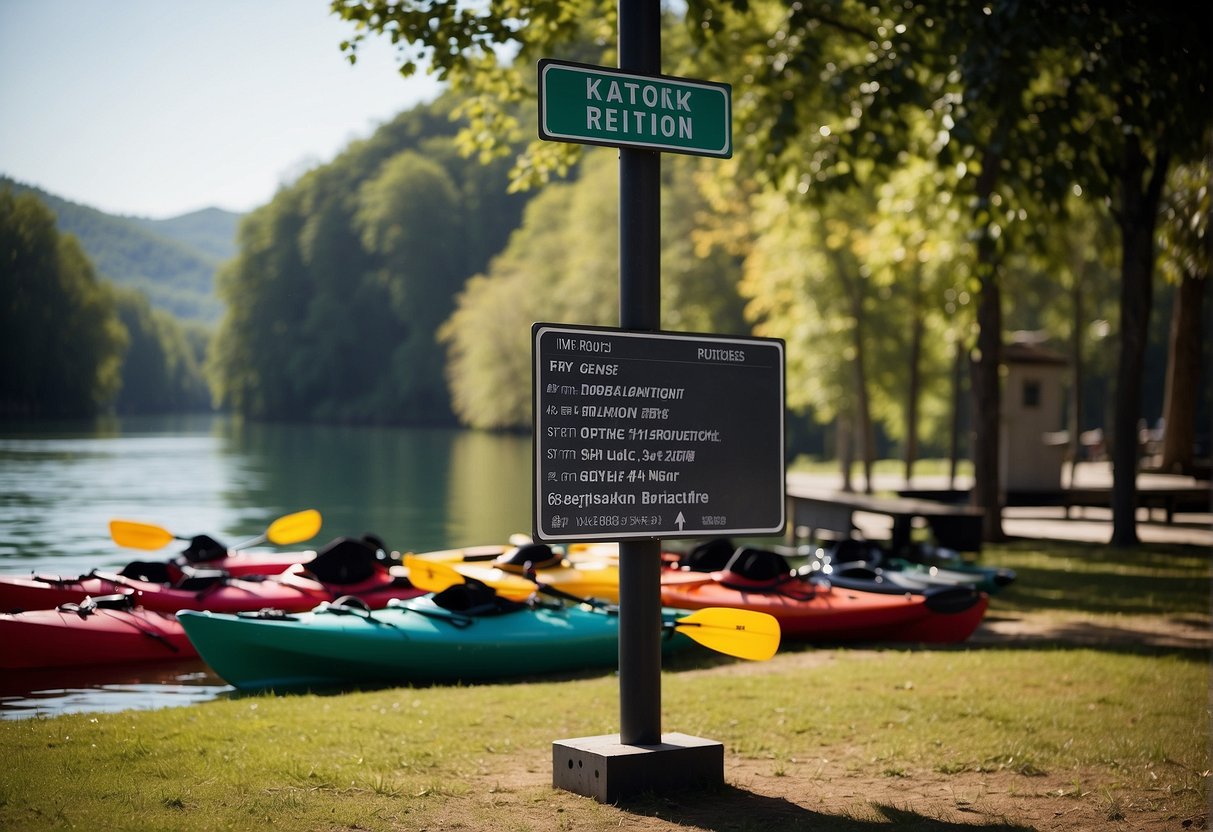
When considering kayak rentals, knowing the various factors influencing the pricing and fees associated with this enjoyable water activity is essential. Rental prices can vary depending on location, type of kayak, duration of rental, and additional equipment needed. Below, we will discuss some critical aspects of kayak rental pricing and fees.
Location plays a significant role in determining the cost of renting a kayak. Rental facilities in popular kayaking destinations often have higher rental fees, while less frequented locations may offer more affordable options.
The type of kayak can also impact the pricing. Typically, a single kayak rental may range between $20 to $40 per hour, while a tandem kayak rental may range from $30 to $50 per hour. Rental fees for an entire day can range from $50 to $100 for a single kayak and $70 to $120 for a tandem kayak, as stated by Kayak Rock.
The duration of the rental can also result in discounts. Multi-day rentals may see a reduced price per day, sometimes dropping to around $20 to $40 per day when rented for five days in a row, according to Kayakpapa.
Credit card or debit card information may be required to secure the booking when making a reservation. In some cases, rental businesses may pre-authorize a certain amount as a security deposit, ranging from a partial to the total rental fee.
Return fees might be applied if the equipment is returned late, damaged, or unused. SilverFinn Kayaking states that lost, broken, damaged, or stolen equipment could result in charges to the renter’s credit card for the total retail price of the kayak (which can range from $375 to $550) and a $100 fee for the paddle.
In summary, when planning a kayaking adventure, it is essential to research and compare pricing, fees, and policies for different rental facilities. These critical factors will ensure a smooth and enjoyable kayaking experience.
Exploring Destinations by Kayak
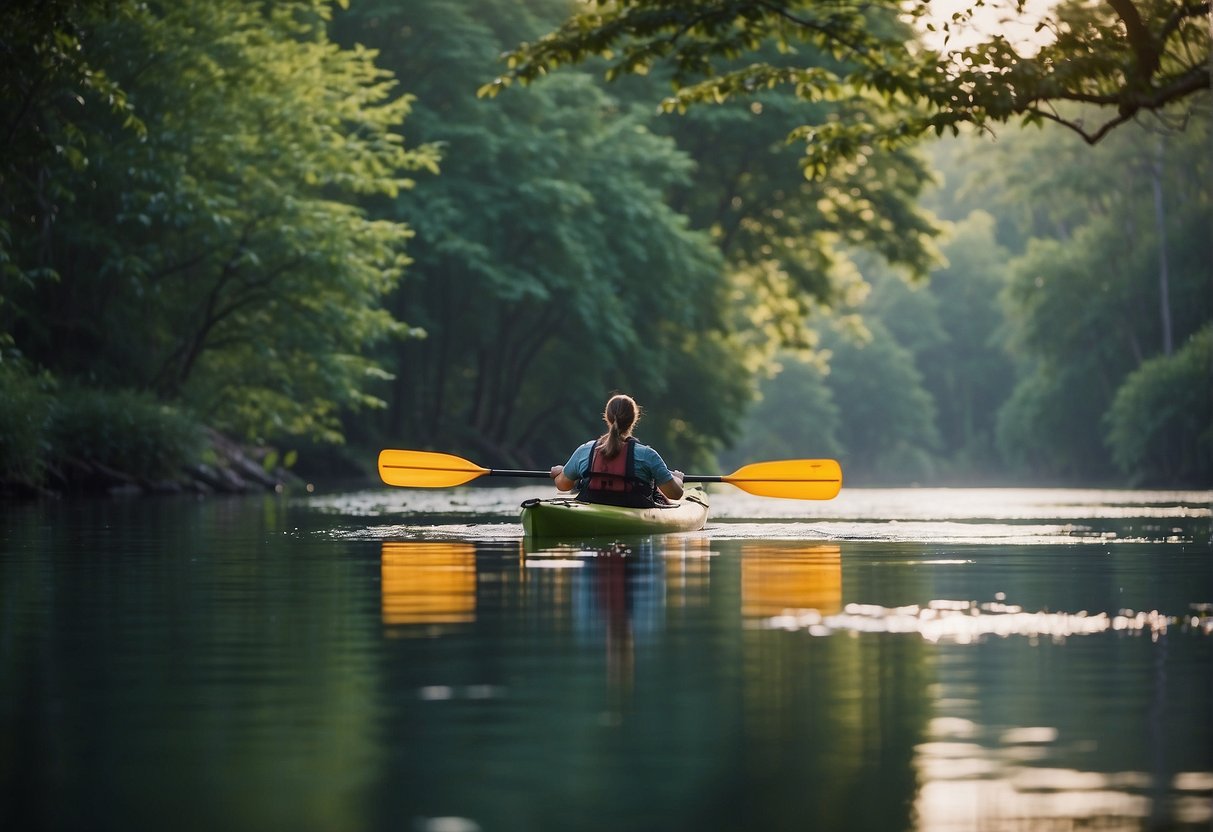
Kayaking is an excellent way to discover new destinations and experience their natural beauty from the water. Numerous locations worldwide cater to kayaking enthusiasts, offering picturesque paddling spots, unique wildlife, and adventure opportunities. Some exceptional kayak destinations include the sunny shores of Destin, the historic charm of Paris, and the breathtaking wilderness of Canada.
Destin, a popular vacation spot on Florida’s Emerald Coast, boasts crystal-clear waters and abundant marine life. Kayakers can paddle alongside sea turtles, dolphins, and even sharks. The area offers several kayak rental options, allowing visitors to choose between guided tours or self-guided excursions.
Paris might not be the first city that comes to mind for kayaking, but the French capital offers some unique and unforgettable paddling experiences. Kayakers can explore the famous waterways of the Seine River, with opportunities to admire iconic landmarks such as Notre Dame Cathedral and the Eiffel Tower from a different perspective.
In Canada, outdoor adventurers will find an endless array of stunning kayaking destinations. The country’s diverse landscapes provide various paddling opportunities, from pristine lakes to rushing rivers. The Pacific Northwest, in particular, offers a fantastic mix of coastal and inland kayaking experiences. While kayaking in Canada, paddlers may spot eagles, whales, and seals.
Here is a summary of the three featured kayak destinations:
| Location | Highlights | Kayak Difficulty Level |
|---|---|---|
| Destin | Crystal-clear waters, marine life, guided tours | Easy |
| Paris | Seine River, iconic landmarks, urban exploration | Easy |
| Canada | Stunning landscapes, diverse wildlife, various waterways | Mixed difficulty |
Renting a kayak in these locations allows novice and experienced paddlers to immerse themselves in these beautiful destinations’ sights, sounds, and sensations.
Specialty Kayaking Experiences
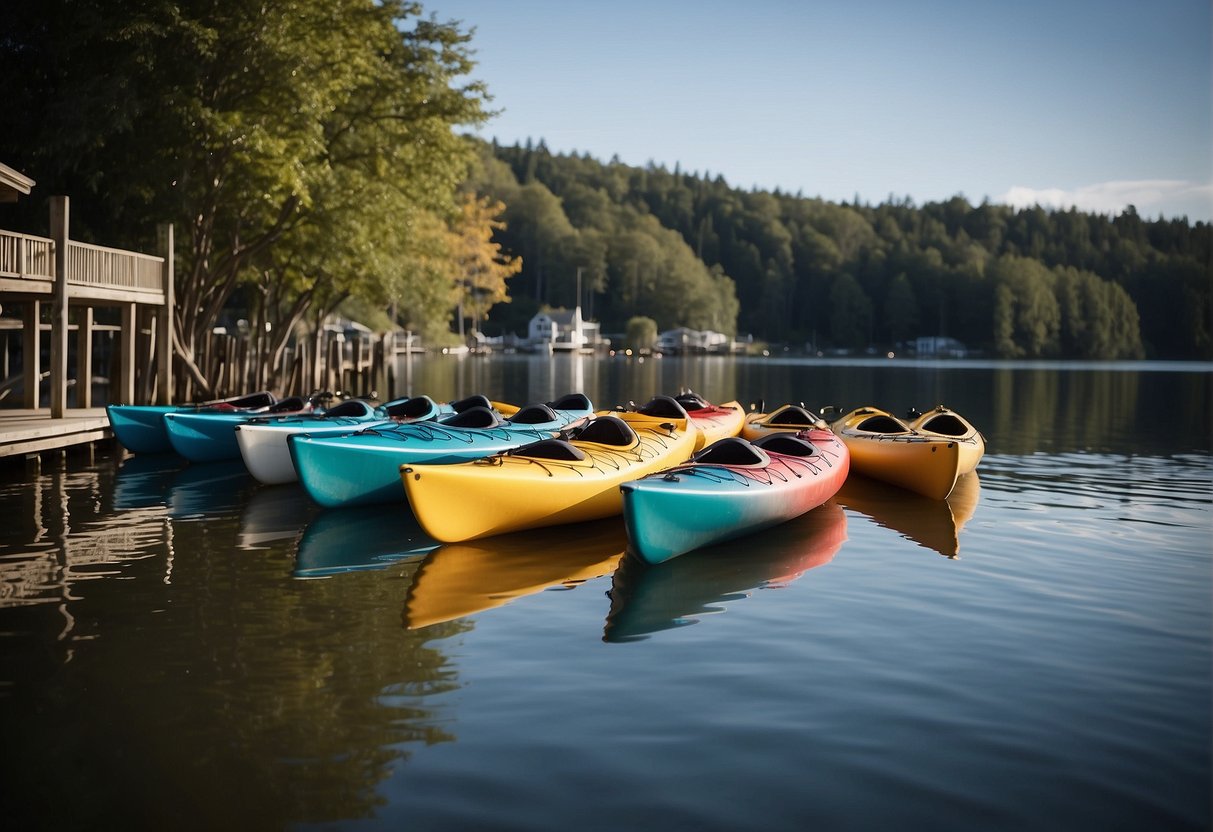
Kayaking is a versatile sport that offers a variety of unique experiences for those looking to try something different. This section will explore three popular options: Kayak Fishing Adventures, Nighttime Kayaking, and Eco-Tours.
Kayak Fishing Adventures
Kayak fishing elevates the traditional angling experience by combining it with the thrill of paddling. Instead of fishing from the shore or a motorized boat, you can navigate through narrow waterways and shallow areas, getting closer to the fish. Kayak fishing is an eco-friendly way to enjoy nature while catching fish such as bass, trout, and saltwater.
Kayak Types:
- Sit-On-Top Kayaks: Easier to enter and exit, provide a stable platform for fishing, and often have built-in features catering to anglers.
- Sit-In Kayaks: They offer better protection from the elements and can be easier to paddle but may have less storage space for gear.
Gear:
- Fishing rod and tackle
- PFD (personal flotation device)
- Paddle
- Anchor or drift sock
- Leashes for securing gear
Nighttime Kayaking
For those seeking a new and enchanting experience, nighttime kayaking offers a chance to explore waterways under darkness. Paddling at night can be a serene and magical experience, with opportunities to witness bioluminescent organisms, stargaze, or enjoy the tranquility of the water.
When choosing a nighttime kayaking adventure, consider the following safety tips:
- Wear reflective gear: Ensure you are visible to others by wearing a reflective PFD and attaching reflective tape to your paddle and kayak.
- Use lights: Attach a white light to the rear of your kayak and carry a waterproof flashlight or headlamp for additional visibility.
- Stay close to shore: Navigate familiar waters and remain close to the beach to minimize the risk of getting lost.
Eco-Tours
Eco-tours are designed to explore the natural environment while minimizing the impact on the ecosystem. These guided tours typically involve exploring a particular habitat, such as a mangrove forest, coral reef, or coastal wetland. Participants enjoy paddling and learning about local flora, fauna, and conservation efforts.
A popular eco-tour option is paddle boards, which offer a more relaxed and stable platform for navigating calm waters. Paddle boarding is suitable for all ages and skill levels and allows for a unique vantage point above the water, making it easier to observe marine life.
When planning an eco-tour, consider the following tips:
- Choose a reputable tour operator with a focus on conservation
- Wear appropriate gear, including a properly fitted PFD and water shoes
- Bring sun protection, water, and snacks in reusable containers
Complementary Activities and Rentals
When planning a kayaking adventure, it’s also a good idea to consider complementary activities and rentals that can enhance your overall experience. Many kayak rental companies offer additional services and equipment that cater to different needs and preferences, making your trip more enjoyable and convenient. Here are some options to consider:
Transportation: Whether renting a kayak from a nearby location or traveling to a distant paddling spot, reliable transportation makes a significant difference. Some kayak rental companies provide pickup and return services to make getting your kayak to the water easier. If you have your vehicle, options like pickup truck rentals or minivan rentals can provide ample space for transporting your equipment.
Swimming: Although kayaking can be the main focus of your day, swimming is a complementary activity that many paddlers enjoy. While out on the water, take a break to cool off and go for a swim. Don’t forget to pack swimming essentials such as a swimsuit, towel, and water shoes. Some rental companies may also offer floating devices and snorkeling gear for rent.
Safety gear and extra equipment: It’s essential to prioritize safety while out on the water. Many kayak rental companies provide life jackets, helmets, and paddles as part of their rental packages. Inquire about available safety gear and optional extras such as waterproof bags, paddle leashes, and anchors.
Guided tours and lessons: If you’re new to kayaking or want to explore unfamiliar waters, guided tours, and lessons can be a great addition to your rental. Companies often have experienced instructors who can teach paddling techniques and help you safely navigate the water.
Here’s a summary of complementary activities and rentals to consider for your next kayaking trip:
- Transportation: kayak pickup and return services, pickup truck rentals, minivan rentals
- Swimming: swimming essentials and floating devices
- Safety gear and extra equipment: life jackets, helmets, paddles, waterproof bags, paddle leashes, anchors
- Guided tours and lessons: paddling instruction and expert navigation assistance
In conclusion, don’t overlook the importance of complementary activities and rentals when planning your kayaking adventure. These additional services can make your trip more enjoyable and hassle-free.
Frequently Asked Questions
What factors should I consider when choosing a kayak rental service?
When choosing a kayak rental service, consider factors such as the location, types of kayaks available, pricing, and customer reviews. Decide whether you want to paddle solo or tandem, and ensure your chosen service offers the appropriate equipment.
How do I find affordable kayak rentals in my area?
To find affordable kayak rentals in your area, research local businesses through search engines or local directory listings. Compare pricing and services offered, keeping in mind that the cost of renting a kayak may vary depending on the type of kayak and rental duration.
What are the benefits of renting an inflatable kayak?
Renting an inflatable kayak offers several benefits, including easy transportation, compact storage, and a lightweight yet durable construction. Inflatable kayaks can also be less expensive to rent than rigid kayaks, making them an attractive option for budget-conscious paddlers.
Are there specific kayak rental services recommended for beginners?
When searching for a kayak rental service suitable for beginners, look for businesses that offer beginner-friendly equipment, such as stable and easy-to-maneuver kayaks. Some rental services may also provide guided tours, where experienced instructors can teach beginners basic kayaking skills and techniques.
What safety equipment is typically included with a kayak rental?
Kayak rental services should provide essential safety equipment, such as life jackets, helmets, and paddles. In some cases, extra gear like signal whistles, dry bags, and spray skirts may be included or available for an additional fee. Confirm the safety equipment provided by the rental service before making a reservation.
How does the experience differ when renting a kayak at a lake versus a river?
Renting a kayak at a lake generally offers calm and predictable water conditions, making it suitable for beginners or recreational paddlers. Conversely, river kayaking can present varying levels of challenge, depending on the river’s flow, rapids, and technical features. Consider your skill level and desired experience when choosing between a lake or river kayak rental.
Conclusion
Regarding kayak rental options, several factors should be considered to ensure an enjoyable and safe experience. First, it is essential to choose the right kayak for your skill level and the intended purpose of the trip. Renting from a reputable company and selecting a suitable location, like a nearby lake or river, also plays a significant role in a successful kayaking adventure.
One of the most critical aspects of kayak rentals is prioritizing safety. This includes checking the condition of the equipment, wearing appropriate gear like life jackets, and being aware of any required permits or regulations. Moreover, consulting with the kayak rental staff regarding local weather and water conditions is crucial for a smooth voyage.
Kayaking offers various benefits, such as enhancing physical health and providing a unique way to explore nature. To maximize these advantages, consider incorporating sustainable practices when renting a kayak, like choosing eco-friendly companies and following leave-no-trace principles.
Lastly, a profitable kayak rental business thrives by focusing on excellent customer service, strategic marketing, and maintaining high-quality equipment. By understanding your target market and offering diverse rental options, your business will likely succeed in the long run.
In summary, keen attention to detail, proper preparation, and informed decision-making are essential when considering kayak rental options. By following these guidelines, participants can ensure a memorable, safe, and enjoyable paddling experience.



